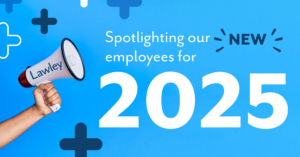Working toward a healthier workplace: Lawley’s Wellness Team featured in The Buffalo News WNY Refresh


Having an in-house corporate wellness team is an added-value resource for Lawley customers to develop a healthier workplace program while creating more health-conscious employees through a culture of workplace wellness. This week, Scott Scanlon, editor for The Buffalo News WNY Refresh section focusing on healthy lifestyle stories across Buffalo, interviewed two Lawley Wellness Coordinators, Carly Kennedy and Maribeth Insana, for a story on how the Lawley Corporate Wellness team develops wellness programs both internally in the Lawley offices and with clients in their companies. Below is the interview, or it can be read in full here.
Working toward a healthier workplace
Lawley – an independent insurance and employee benefits company with nine offices in three states, including its downtown Buffalo headquarters – has taken several steps to boost the health of its 350 employees. It also provides wellness advice and programs to hundreds of other companies.
But in the age of ever-climbing health insurance costs, do these efforts benefit a company?
It depends on how you measure things, said Carly Kennedy and Maribeth Insana, who are among four Lawley wellness and health management specialists.
Health screenings Lawley helped arrange at other companies led at least one worker to find cancer at an earlier stage than he might have otherwise; uncovered other conditions with subtle symptoms; and provided workers with strategies to eat and exercise better.
Q. What programs do you have in the Lawley offices?
Kennedy: We recently launched a virtual platform for our wellness program on our website (lawleyinsurance.com). It’s called Lawley Strong, and we even have a mascot named Arty the Artery. Associates who completed an online health assessment received a FitBit Flex. We also have on-site, 36-panel biometric screening that allows associates who might not get a physical, or even have a doctor, a chance to learn more about their health and any potential health risks. We’re always pushing free annual well visits, colonoscopies, mammograms, other things that people need to be taking advantage of. Early detection is always key.
We have a wellness committee made up of members from almost all of our branches and we work to come up with initiatives for all of our branches, such as a stress management program. We have Lawley Olympics, which we did on the patio here at the headquarters. It consisted of Hula-Hoop contest, bean bag toss, a healthy recipe that you had to come up with and make, then taste testing. To kick it off, one of our owners led us to the oldest tree in Buffalo. Some individuals have standing desks. Everyone has ergonomically designed work stations that fit their needs. We have healthy vending machines through Buffalo Strives. We have a healthy chef that comes in twice a month with homemade healthy foods. We also recently kicked off a CSA with Porter Farms. Each Friday for 17 weeks, we’ll have bags of produce delivered right here on site. The CSA we had to pay out-of-pocket but other programs were completely free.
Q. What sort of employee results have you measured?
Kennedy: In the past nine years, the culture has changed at Lawley to look at VOI rather than ROI – value on investment rather than return on investment. People are taking the stairs more than the elevator. They’re bringing in healthier lunches.
Insana: They’re going for walks on their lunch breaks.
Kennedy: Through our biometric screenings, we’ve seen year over year that we’ve made improvements with blood pressure, cholesterol. We can use that data to plan wellness initiatives.
Q. What are the most-used parts of the program in-house?
Kennedy: About 75 percent of our population participates in the biometric screenings, which is good, because it’s one of the more important parts. In terms of the other wellness initiatives, you can typically see 50 to 60 percent participation.
Q. What top three concerns do employers have as they set up a health and wellness program?
Insana: Time, money, confidentiality.
Kennedy: Some groups don’t have a budget at all. For our benefits clients, this is value-added so the wellness programs we provide are at no cost. They can set up a wellness committee with our help. They can get a wellness newsletter. We offer health management roundtables at our Buffalo and Rochester sites that our clients can attend.
Health screenings Lawley helped arrange at other companies led at least one worker to find cancer at an earlier stage than he might have otherwise; uncovered other conditions with subtle symptoms; and provided workers with strategies to eat and exercise better.
Q. What are the most popular wellness initiatives employers decide to tackle?
Kennedy: Weight loss. Nutrition. Biggest Loser programs always seem to be pretty popular.
Insana: I think stress management has become popular, as well.
Q. What do other companies look to accomplish and what advice do you generally find yourself giving?
Kennedy: Some are implementing programs because it’s the right thing to do. They care about their associates and their health and well-being, while others are looking at that bottom line and trying to reduce health care costs and claims. Or it’s a mix of both.
Insana: Sometimes when you meet with a group, they might want to do just a weight-loss challenge or a seminar. Once you build a relationship with them and they learn about your capabilities and what you can offer, and where you can go with wellness, it helps to build their program down the road.
Q. Have employees or employers seen any decrease in medical costs as a result of these programs?
Kennedy: I don’t know if we have an exact number but I know that for some of our self-funded groups, a key part of keeping costs down is wellness programs.








